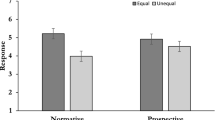Abstract
In recent years, a disagreement has erupted between two camps of philosophers about the rationality of bias toward the near (“near bias”) and bias toward the future (“future bias”). According to the traditional hybrid view, near bias is rationally impermissible, while future bias is either rationally permissible or obligatory. Time neutralists, meanwhile, argue that the hybrid view is untenable. They claim that those who reject near bias should reject both biases and embrace time neutrality. To date, experimental work has focused on future-directed near bias. The primary aim of this paper is to shed light on the debate by investigating past-directed near bias. If people treat the past and future differently with respect to near bias, by being future-directed but not past-directed near biased, then this supports a particular version of the hybrid view: temporal metaphysic hybridism. If people treat the past and future the same with respect to near bias, then this supports a simple version of time neutralism, which explains both future bias and near bias in terms of the functioning of a single mechanism: the anticipatory/retrospectory mechanism. Our results undermine the claim that people are future-directed, but not past-directed, near biased, and hence do not support temporal metaphysic hybridism. They also fail to support simple time-neutralism; instead, they suggest that there are multiple mechanisms that differently shape future- and past-directed preferences.



Similar content being viewed by others
Notes
While discount rates feature prominently in economic models of decision making, there is an important difference between the discounting of positive and negative experiences—which John Broome (1991) calls “pure” discounting—and the discounting of commodities used by economists in cost-benefit analysis. This paper concerns pure discounting.
See Greene and Sullivan (2015, §2). Sidgwick (1884, 380–1) writes, “The mere difference of priority and posteriority in time is not a reasonable ground for having more regard to the consciousness of one moment than to that of another. The form in which it practically presents itself to most men is ‘that a smaller present good is not to be preferred to a greater future good’ (allowing for difference of certainty).” Rawls (1971, 293) reiterates the point: “A present or near future advantage may be counted more heavily on account of its greater certainty or probability, and we should take into consideration how our situation and capacity for particular enjoyments will change. But none of these things justifies our preferring a lesser present to a greater future good simply because of its nearer temporal position.” (See also Lewis (1946); Nagel (1970); Broome (1991); and Brink (2011)).
Heathwood (2008, 56–7): “[A future-biased agent] is being completely reasonable in preferring that his pain be in the past. In fact, even his no longer caring at all that it occurred is perfectly fitting—not at all in inappropriate. Why should he care about it now? No reason—it’s over and done with.” Likewise, Sullivan (2018, 58) claims that “we assign no value to a merely past painful experience or pleasurable experience”. See also Parfit (1984, 173) and Dorsey (2018) (though neither defends this view as part of a commitment to temporal metaphysic hybridism.).
Early experiments on future-directed near bias—what social scientists call temporal discounting—indicate a “pervasive devaluation of the future” (Ainslie and Haslam (1992, 59)). For example, in the experiments of Thaler (1981); Hausman (1979); and Akerlof (1991), people assigned less value to future money, time, and effort, respectively, than their present analogues. Similar results in animal studies backed this idea; e.g., Green et al. (1981). However, a meta-analysis done between 1978 and 2002 (Frederick et al. (2002, 377)), found “tremendous variability” in estimates of people’s average discount rate.
These vignettes are based on those used in Greene et al. (2020).
Cf. Greene et al. (2020).
One might worry that these results are due to using hypothetical scenarios to test participants’ preferences. At least in some behavioural economics studies, participants’ preferences are tested under non-hypothetical conditions in which, for instance, they gain or miss out on real money. Clearly, the testing of past-directed preferences cannot be done in anything other than a hypothetical manner. Nevertheless, it’s worth noting that a number of studies have found very similar results when comparing participants’ responses to hypothetical and non-hypothetical scenarios (Lagorio and Madden (2005); Johnson and Bickel (2002)).
References
Ainslie, G., and N. Haslam. 1992. Self-control. In Choice over time, eds. G. Loewenstein & J. Elster. Russell Sage Foundation.
Akerlof, G.A. 1991. Procrastination and obedience. The American Economic Review 81 (2): 1–19.
Bar-Anan, Y., T. D. Wilson, and D. T. Gilbert. 2009. The feeling of uncertainty intensifies affective reactions. Emotion 9 (1): 123–127.
Benzion, U., A. Rapoport, and J. Yagil. 1989. Discount rates inferred from decisions: An experimental study. Management Science 35 (3): 270–284.
Bickel, W.K., R. Yi, B.P. Kowell, and K.M. Gatchalian. 2008. Cigarette smokers discount past and future rewards symmetrically and more than controls: Is discounting a measure of impulsivity? Drug and Alcohol Dependence 96: 256–262.
Brink, D.O. 2011. Prospects for temporal neutrality. In The Oxford Handbook of Philosophy of Time, ed. Craig Callender. Oxford: Oxford University Press.
Broome, J. 1991. Weighing goods: Equality, Uncertainty and Time. Basil Blackwell.
Byrne, C.A., I.E. Hyman, and K.L. Scott. 2001. Comparisons of memories for traumatic events and other experiences. Applied Cognitive Psychology 15: 119–133.
Caruso, E., D.T. Gilbert, and T.D. Wilson. 2008. A wrinkle in time: Asymmetric valuation of past and future events. Psychological Science 19 (8): 796–801.
Craig, W.L. 1999. Tensed time and our differential experience of the past and future. Southern Journal of Philosophy 37: 515–537.
D’Argembeau, A., C. Comblain, and M. Van der Linden. 2003. Phenomenal characteristics of autobiographical memories for positive, negative, and neutral events. Applied Cognitive Psychology 17: 281–294.
Destun, L.M., and N.A. Kuiper. 1999. Phenomenal characteristics associated with real and imagined events: The effects of event valence and absorption. Applied Cognitive Psychology 13: 175–186.
Dorsey, D. 2018. Prudence and past selves. Philosophical Studies 175 (8): 1901–1925.
Dougherty, T. 2015. Future-bias and practical reason. Philosophers’ Imprint 15(30): 1–16.
Frederick, S., G. Loewenstein, and T. O'donoghue. 2002. Time discounting and time preference: A critical review. Journal of Economic Literature 40 (2): 351–401.
Frijda, N.H. 1988. The laws of emotion. American Psychologist 43: 349–358.
Green, L., E.B. Fisher, S. Perlow, and L. Sherman. 1981. Preference reversal and self control: Choice as a function of reward amount and delay. Behaviour Analysis Letters 1: 43–51.
Greene, P. and M Sullivan, (2015). ‘Against time bias’ Ethics 125 (4): 947–970.
Greene, P., A.J. Latham, K. Miller, and J. Norton. 2020. Hedonic and non-hedonic bias towards the future. Australasian Journal of Philosophy. https://doi.org/10.1080/00048402.2019.1703017.
Hare, C. 2007. Self-Bias, time-Bias, and the metaphysics of the self and time. Journal of Philosophy 104 (7): 350–373.
Hare, C. 2008. A puzzle about other-directed time-Bias. Australasian Journal of Philosophy 86 (2): 269–277.
Hare, C. (2013). Time—The emotional asymmetry. In A Companion to the Philosophy of Time, eds. Adrian Bardon and Heather Dyke, Wiley Blackwell, pp. 507-520.
Hausman, J.A. 1979. Individual discount rates and the purchase and utilization of energy-using durables. The Bell Journal of Economics 10: 33–54.
Heathwood, C. 2008. Fitting attitudes and welfare. Oxford Studies in Metaethics 3: 47–73.
Hume, D. 1738. A treatise of human nature. Oxford University Press.
Johnson, M. K., M. A. Foley, A. G. Suengas, and C. L. Raye. 1988. Phenomenal characteristics of memories for perceived and imagined autobiographical events. Journal of Experimental Psychology: General 117: 371–376.
Johnson, M.W., and W.K. Bickel. 2002. Within-subject comparison of real and hypothetical money rewards in delay discounting. Journal of the Experimental Analysis of Behavior 77: 129–146.
Lagorio, C.H., and G.J. Madden. 2005. Delay discounting of real and hypothetical rewards III: Steady-state assessments, forced choice trials, and all real rewards. Behavioural Processes 69: 173–187.
Lewis, C.I. 1946. An analysis of knowledge and valuation. LaSalle, IL: Open Court.
Liberman, N., M. Sagristano, and Y. Trope. 2003. The effect of temporal distance on level of construal. Journal of Experimental Social Psychology. 38: 523–535.
Loewenstein, G. 1987. Anticipation and the valuation of delayed consumption. The Economic Journal 97 (387): 666–684.
Loewenstein, G. 1996. Out of control: Visceral influences on behavior. Organizational Behavior and Human Decision Processes 65 (3): 272–292.
Loewenstein, G., and D. Prelec. 1991. Negative time preference. The American Economic Review 81 (2): 347–352.
MacKeigan, L.D., L.N. Larson, J.R. Draugalis, J.L. Bootman, and L.R. Burns. 1993. Time preference for health gains versus health losses. Pharmacoeconomics 3 (5): 374–386.
Molouki, S., D.J. Hardisty, and E.M. Caruso. 2019. The sign effect in past and future discounting. Psychological Science 30 (12): 1674–1695.
Nagel, T. 1970. The possibility of altruism. Oxford: Clarendon.
Parfit, D. 1984. Reasons and persons. Oxford: Oxford University Press.
Pearson, O. 2018. Appropriate emotions and the metaphysics of time. Philosophical Studies 175 (8): 1945–1961.
Prior, A.N. 1959. Thank goodness that’s over. Philosophy 34 (128): 12–17.
Rawls, J. 1971. A theory of justice. Belknap: Cambridge, MA.
Schlesinger, G. 1976. The stillness of time and philosophical equanimity. Philosophical Studies 30: 145–159.
Sidgwick, H. 1884. The methods of ethics. London: Macmillan.
Soman, D., G. Ainslie, S. Frederick, X. Li, J. Lynch, P. Moreau, A. Mitchell, D. Read, A. Sawyer, Y. Trope, K. Wertenbroch, and G. Zauberman. 2005. The psychology of intertemporal discounting: Why are distant events valued differently from proximal ones? Marketing Letters 16 (3/4): 347–360.
Suchman, Edward A. 1950. The intensity component in attitude and opinion research, in Measurement and Prediction, Samuel Stoffer et al., eds., Princeton: Princeton University Press.
Suhler, C., and C. Callender. 2012. Thank goodness that argument is over: explaining the temporal value asymmetry. Philosophers Imprint 12: 1–16.
Sullivan, M. 2018. Time biases. Oxford: Oxford University Press.
Thaler, R. 1981. Some empirical evidence on dynamic inconsistency. Economics Letters 8 (3): 201–207.
Van Boven, L., and L. Ashworth. 2007. Looking forward, looking back: Anticipation is more evocative than retrospection. Journal of Experimental Psychology 136 (2): 289–300.
Van Boven, L., J. Kane, A.P. McGraw, and J. Dale. 2010. Feeling close: Emotional intensity reduces perceived psychological distance. Journal of Personality and Social Psychology 98 (6): 872–885.
Wakslak, C.J., S. Nussbaum, N. Liberman, and Y. Trope. 2006. The effect of temporal distance on the structure of the self concept. Unpublished manuscript.
Yehezkel, G. 2014. Theories of time and the asymmetry in human attitudes. Ratio 27 (1): 68–83.
Yi, R., K.M. Gatchalian, and W.K. Bickel. 2006. Discounting of past outcomes. Experimental and Clinical Psychopharmacology 14 (3): 311–317.
Author information
Authors and Affiliations
Corresponding author
Additional information
Publisher’s Note
Springer Nature remains neutral with regard to jurisdictional claims in published maps and institutional affiliations.
Rights and permissions
About this article
Cite this article
Greene, P., Holcombe, A., Latham, A.J. et al. The Rationality of Near Bias toward both Future and Past Events. Rev.Phil.Psych. 12, 905–922 (2021). https://doi.org/10.1007/s13164-020-00518-1
Accepted:
Published:
Issue Date:
DOI: https://doi.org/10.1007/s13164-020-00518-1




